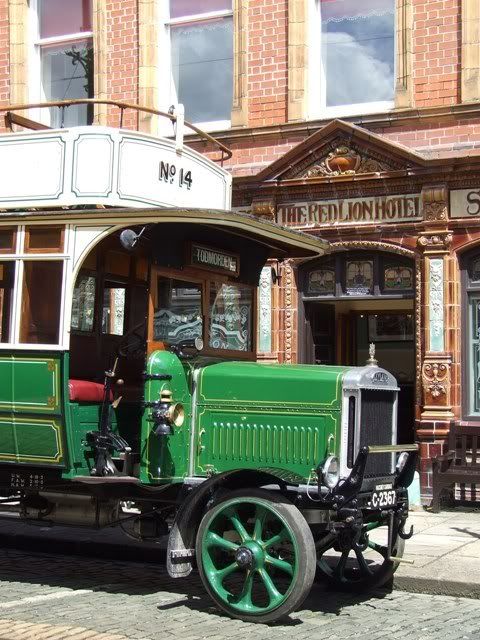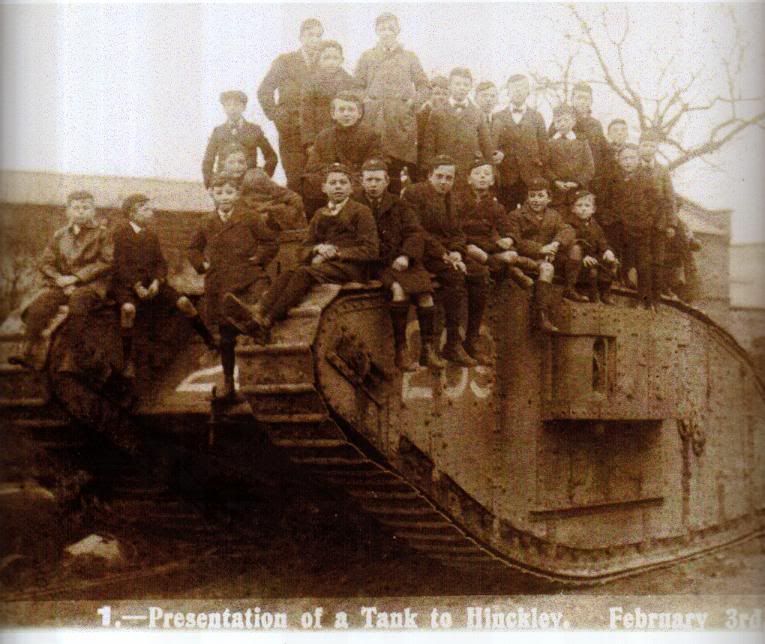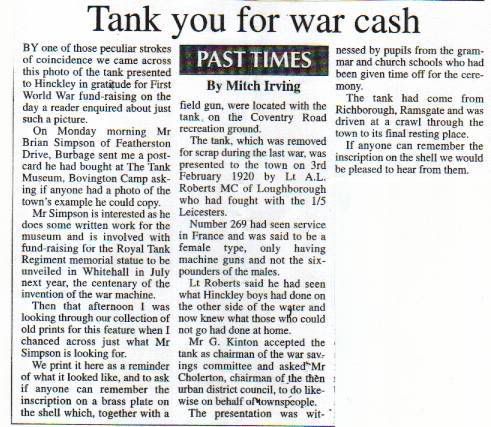-
Posts
646 -
Joined
-
Last visited
Content Type
Profiles
Forums
Gallery
Blogs
Events
Articles
Store
Downloads
Posts posted by Rlangham
-
-
If 'almost' a quad.... then an FWD?
-
For this last post, i'll use a mixture of the war diary and other sources to try and keep it relatively brief, but cover the whole of the days events.
'14th July 1916 - ATTACH ON BAZANTIN LE PETIT WOOD and village by the 110th Infantry Brigade. The battalion was drawn up for the assault in four lines.'
The 7th Battalion was to lead the attack, along with the 6th, the 8th and 9th were in support.
3.25am, zero hour - whistles blew and men went over the top. Enemy machine gun and shell fire started almost immediately. The 7th was held up by a machine gun for around twenty minutes until grenade bombers of the 6th put it out of action. At around 4am, D company 7th Leicesters advanced too quickly and were caught up in the lifting barrage, causing casualties. Slowly, and with mounting casualties, the battalion and the rest of the 110th Brigade fought their way through the maze of trenches, shell holes and smashed trees of Bazentin le Petit wood. By the afternoon, most of the wood had been occupied including Forest Trench, the second objective of the Brigade.
At about 7pm, a last effort by the 7th Battalion removed the rest of the Germans from the wood, already difficult due to a long day of fighting, but also due to thick undergrowth making visibility and movement difficult. With darkness falling, the fighting gradually came to a stop. All the objectives had been taken, but at a heavy cost. Each Battalion lost around 100 men killed and two hundred wounded.
A few days later, the 110th left the front line. However, they were to return to the Somme and go over the top again, in September.
-
13th July 1916 - After a more or less slow bombardment all day including 77mm guns the Battalion was relieved by the 10 KOYLI and marched back for rest to Fricourt
-
They can't fly due to the CAA not letting them, probably fortunately! I'd love for them to do a Hamilcar afterwards, what a beast that would be
-
12th July 1916 - Quadrangle trenches and Bottom wood. Intermittent bombardment all day. We suffered about 30 casualties including 2 Lt H Spencer D Compant killed.
-
Nice - i'll be there on the 3rd August for the Military Air Pageant in my WW1 kit
-
The film Samurai Commando Mission 1549 or something like that is currently on Bravo2 for those that have it!
-
11th July 1916, Bottom Wood - The Battalion having moved up , the 7th Battalion Yorkshire Regiment were relieved early in the morning. Guides were provided at Fricourt, but it was almost daylight before the relief was complete. The Quadrangle trench was occupied by (?) with a platoon from BTD in the Quadrangle Support. HQ A company and the remainder of B company were in Bottom Wood. During the night previous and daytime, the enemy kept up a slow bombardment with 105mm shrapnel and 150mm Howitzers.
-
Where's the last one, Tim? Those busses in the background look nice. I trust most of these chassis shown have been saved?
-
Ah, could be - or Brigade parades, shorthanded somehow. Here's today's;
10th July 1916 - The Battalion left Hangest at 1am and marched to Ailly entraining there for Merricourt which was reached about 11am. Buses were provided to Meault where the rest of the day was resting, until 11pm
Afraid no map this time, as couldn't get google maps to work!
-
What's so bad about it? Not many chances in the year to see/be a WW1 Tommy, so i'm taking it!
-
Anyone at Detling, 23rd-25th August this year?
http://www.military-odyssey.com/
I'll be there as WW1, only Saturday and Sunday i'm afraid though
-
9th July 1916 - (can't make it out - same for other dates, looks like ' bry parades ' - any ideas?)
-
Thanks Snapper - not from a microlight, from a Stampe SV.4 biplane, like a Belgian Tiger Moth, and used as a WW1 plane in pretty much every WW1 aviation film. I'm yet to visit Polygon Wood on the ground - I can understand what you mean about gloomiest and saddest, it looked so from the air on a bright, hot April day, i'd like to visit in September/October when the Leicesters were there for the proper effect
-
Is the Ford civilian or ex-military? For £3,000 you can get a Ford model T almost complete that needs restoring nowadays!
-
Food is alright, fairly decently priced actually for a museum, considering most places grab you by the wallet and squeeze (*cough* Imperial War Museum *cough*). There's the Cliffe Inn about 200/300 metres downhill from the museum which has a decent selection of cheap yet basic (just how I like it!) food. There's also a pub on site which serves alcohol and possibly food but not sure. The site starts with the town area, consisiting of an exhibition hall, sweet shop, ice cream booth, souvenir shop, tea rooms, pub, workshop, tram sheds and a tram museum. Must be at least fifty trams on site of different eras etc. As to how best to enjoy it, well, it's easily all done in a couple of hours including a tram ride.
The busses are only there for last weekend and the coming weekend, and even then they weren't for the public to ride. There's usually about four trams in service I think, although no doubt more can be put on depending on how many public there are. From the town, the tram heads out into the countryside, with stops by the car park/entrance and an area with mining equipment and a couple of small shops. It then heads about a mile into the countryside with spectacular views, then comes to a terminus where you can't get off due to unchartered mine shafts, the tram electric pole is turned around you head back into town
-
4th July 1916 - (can't make it out)
5th July 1916 - (can't make it out)
6th July 1916 - 110th Infantry Brigade transferred to 21st Division. The Battalion marched to TALMAS, falling in 2AM and arriving 9AM. The (brigade?) commander wished good bye and good luck at PAS

7th July 1916 - Falling in at 9AM we marched to HANGEST arriving 4.30PM

8th July 1916 - Billets. Resting
-
Thanks - I thought it was weird as i've seen photos of WW1 Leyland X2's with the deep radiator, yet the sign saying it was a Leyland X2 was on the one i've captioned. I'll upload a photo of the charabus too later
-
There's the Leyland Society event next weekend, all the Leyland's will still be there. They've built an enormous white garage out of scaffolding and plastic to protect them
-
Don't think so - do you have a photo of one? Only recall Trams there, apart from the Leyland's as well
-
-
Mostly Edwardian period street scenes here, hope you enjoy them


Leyland Charabanc, one of eight Leyland's (mostly pre-WW1) driving up and down. Charabanc's such as this one were used for troop transport in the war

Sums up most of the weekend - raining, taking cover in the bandstand, and no public!

'Join T'Army' with the Leeds Pals tram - I particularly like the iron cross on the front and 'Berlin' on the destination blind

Oldest motor bus in the UK, 1908 Leyland X2





-
Hope this is of interest - I thought i'd copy the war diary of the 7th Battalion Leicestershire Regiment in the lead up to their first battle on the Somme in July 1916, day by day (although for Saturday and Sunday i'll have to do those on Sunday night or Monday morning). At this time, the 7th Battalion was part of the 110th Brigade comprised of the 6th, 7th, 8th and 9th Battalions Leicestershire Regiment, and still in the 37th Division.
3rd July 1916 - The Battalion marched to Wallincourt (should be Warlincourt), via St Amand and Gaudiempre. The night before, they were in billets at Souastre.

-
Hinckley used to have a Mk IV Female Tank from 7th February 1921 onwards - in my home town (i'm about 2 miles from Hinckley) there was a German field gun in the park, it was buried and the location is now a kiddies sandpit - anyone got a spare shovel?

And an article on it - although it says it served in France, just about every presentation tank was claimed to have seen service, whereas the vast majority were only used as training tanks at Bovington - the lack of ditching rails on the top of the tank seems to reinforce this













Dodge WC51/52 in British service
in American Vehicles
Posted
Hi all, I was wondering if anyone had any photos etc of the Dodge WC51/52 in British service in the far east, such as how widespread they were, and what differences there were to normal Dodge WC's? I've seen photos of Dodge's used by 656 squadron who flew army co-operation Auster aircraft, with cut down backs and trailers used for transporting the aircraft around.
I'd love to have a Dodge WC52 (just look better with the winch!) in British far east colours one day.... maybe after university